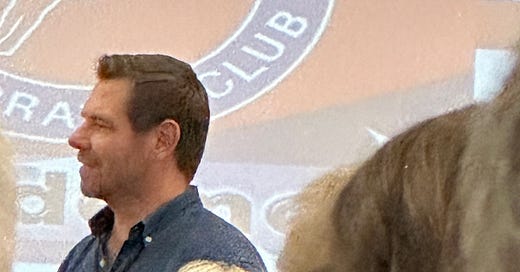How this Ends
Part I of a series examining how elected officials, grass roots movements, and political scientists envision a way out of the current crisis
Why, some might wonder, did the Northern California town of Folsom, California—population circa 84,000—become a whistle stop for key Democrats during their recent Congressional recess? The answer is simple: Folsom, situated in a potentially vulnerable, historically Republican district, is a stepping stone on what some Congressional Democrats see as a path forward to eventual regime change.
Democrats in Congress, including Alexandria Ocasio-Cortez, Bernie Sanders, and Eric Swalwell are counting on electoral politics in places like Folsom to save us. To shift metaphors, their vision is of a game of small ball, and the key moments on their event horizon of their game take place in late 2025, 2026, and 2028, with each moment contingent upon the one which precedes it.
This coming fall, when Democrats aim to elect governors in Virginia and New Jersey, for example, their goal is to ensure that—-notwithstanding the SAVE act and other voter suppression efforts—-the elected governors of those states will, theoretically, be able to oversee free and fair elections the following year. And the 2026 and 2028 goals are, of course, the flipping of key seats in red districts in order to regain a majority in Congress, followed by a return of a Democrat to the highest office in the land.
Energized elected leaders like AOC and Sanders used the recent recess to hold massive pop-up rallies like those in Folsom, Missoula, and Salt Lake City to lay out an unapologetic, bold, and progressive vision—-a recipe largely crafted from the still-delicious leftovers of Sanders’ 2020 presidential platform and AOC’s signature grassroots populism but now seasoned with spice from the present-day. Specifically, now that we’ve seen up close and personal how dark money and the tech broligarchy work, it’s more important than ever to embrace imperatives like taxing the rich, universal healthcare, green jobs, and a myriad of social justice causes that have long been honored only at the far left fringes of the Party.
Swalwell, who held an empty chair town hall in Folsom on April 26, drawing a much more modest, less diverse, and older-skewing crowd offered a more stripped down and simplified platform, one that skews more to the center. Perhaps he was playing to the eveningʻs audience (when Swalwell asked how many in the attendance were on Social Security, more than three quarters raised their hands), but his plan seems decidedly to eschew what he implied were fringe issues. Acknowledging that this momentʻs Democratic Party is, in the wake of the Partyʻs tragic bid for the presidency, a “blank page,” Swalwell proposed a reconstituted DNC that eschews identity politics and returns to what he argues is a tried-and-true formula. Swalwellʻs simplified platform is built on two pillars only: 1) healthcare (providing it widely, and investing in research and development) and 2) Social Security. Thatʻs it. Thatʻs all she wrote.
Where, in other words, AOC and Bernie are angling for a platform that embraces the left, and hence embraces disaffected young voters who didnʻt turn out in 2024, Swalwell advocates for a return to what have been Democratic Party values throughout the 20th and early 21st centuries. Explicit in Swalwellʻs vision, too, is a party makeover from the inside out, a temperament transplant, if you will. No more Mr. Nice Guy. Come the time of a Democratic majority, those in Congress must no longer squander their opportunity to act but seize it. Gone should be the days of Schumer-like shuffling of feet and other needless capitulations when Dems wring their hands rather than grab onto the reins with those hands.
Both AOC/Bernieʻs and Swalwellʻs visions are certainly refreshing, uplifting, forward thinking, and they provide us with at least two possible, practical paths forward, not to mention moments of something like joy on days when hourly we are bombarded with news of the destruction of democracy. You can’t help but walk away from a buoyant rally of some 30,000 people or a packed empty chair town hall feeling as though you’ve gotten a nice shot in the arm of optimism, a reason to get out of bed the next day and keep fighting.
But will electoral politics be the means by which the Trump regime comes to its eventual end? What are the limits to this approach? One limit is the assumption that free and fair elections will be possible. Good news on that front is recent, robust judicial pushback regarding Trumpʻs unconstitutional voter suppression executive order. Bad news includes concern (though there has been no verified reporting on the issue yet) over the ways in which someone like Elon Musk might be able to use technology to subvert the electoral process.
But what are some other paths forward? Iʻll examine that in my next installment. In the meantime, we can hope that regime change comes sooner rather than later. Sooner, one wonders, than 2028? As my Jewish grandmother used to say in her native Yiddish, "fun dein moyl in Gots oyern.” From your mouth to godʻs ears.
About Julie Checkoway: The New York Times bestselling author of The Three-Year Swim Club now documents the rise of people-powered movements for 50501 CA.
Together, we defend what they’re trying to erase. — 50501 CA
Share this newsletter with others who value democracy.
Connect With Us
Discover more ways to get involved: Visit our Linktree for local volunteer opportunities, upcoming events, and resources to support the 50501 CA movement in your community.



